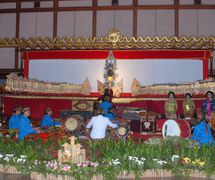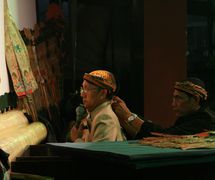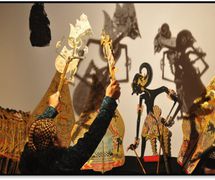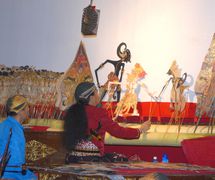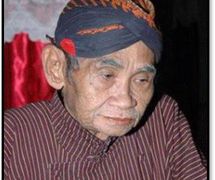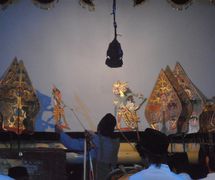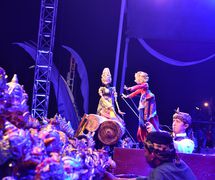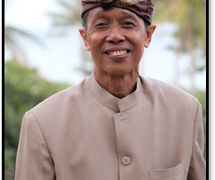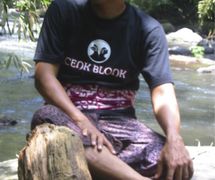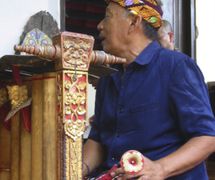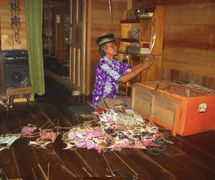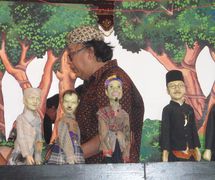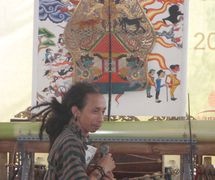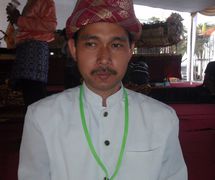The puppeteer-narrator in wayang, the traditional theatre of Indonesia, the puppet art (dhalang, in Javanese).
A dalang is the head of his troupe who gives performances sponsored by patrons. He (or she) hires some or all the musicians who will accompany the performance directed by the dalang‘s verbal and sound cues. The dalang delivers the narration, mood songs, and all the dialogue as he presents a story for three to eight hours. In most instances, the repertoire is derived from the Mahabharata cycle though Ramayana, Javanese legends, Islamic stories, local chronicles and recent history may be presented as well. The dalang may interface with female singers who spell him at points in the show. Figures come to life in his adroit manipulation which highlights dance and fight sequences.
Most dalang know how to carve figures and many innovate new figures that appeal to the current audiences. The accomplished dalang is a master of narrative, dance, music, visual arts and iconography, local culture, ritual lore, political and social critique, comedy, philosophy and religion. The all-round mastery of this proto-typical artist causes people to draw analogies between puppeteer and god on the metaphysical level, and puppeteer and ruler on the physical plane. The dalang‘s mark is everywhere though he may remain unseen.
Indeed, in Bali the first dalang is said to be the god Iswara (an incarnation of Shiva) who came down to earth to exorcise demons. Javanese dalang say the first puppeteer was Sunan Kalijaga who used the art to convert Java to Islam in the 15th century, and they see themselves as continuing this Sufi legacy. Many claim lineal descent from Kalijaga’s follower Sunan Panggung (“Saint of the Stage”). Puppeteers were and, to an extent, are valued for ritual as well as entertainment functions at life cycle or other ceremonies.
Actor in the Community
Political and social critique is part of each performance, and dalang consider wayang a mode of mass communication. Since the establishment of the Republic of Indonesia in l950, dalang have been called together for innumerable government “up-gradings” that induce performers carry government messages – from family planning, to pro- (l950-l965), or anti- (1965-1998) communist propaganda. Political parties pay them to perform in their election campaigns. Dalang speak of pressures of censorship or self-censorship from the colonial period to the fall of Suharto (Soeharto) in 1998. Since at least the l960s, companies have hired dalang to advertise products in their shows.
Dalang are found in areas which have been influenced by Java, including Central and East Java, Sunda (West Java), Bali, Lombok, Sumatra, Kalimantan and areas of the Malay Peninsula. Wherever the Javanese have migrated dalang are found – from Suriname (in South America) to Irian Jaya (today, Papua). Since the 1950s, a growing number of Indonesian performers come from outside traditional families of puppeteers. Beginning in the l960s, a number of Europeans, Australians, and Americans have joined dalang ranks by studying and performing wayang in Indonesia and abroad.
PEPADI (Persatuan Padalangan Indonesia, Indonesian Organization of Dalang), established in 1971, and SENAWANGI (Sekretariat Nasional Pewayangan Indonesia, National Secretariat of Indonesian Wayang), established in l975, have worked to unify dalang across Indonesia and the world. They host a Pekan Wayang (Wayang Festival) approximately every five years. There, dalang can meet and share their work.
A ritual song used in the ruwatan (“making safe”) exorcism of Javanese puppetry calls for Banyak Dalang (“Many Puppeteers”) since puppeteers safeguard the world. The mantra’s intent is answered in the many dalang, in what is now an international art.
(See Indonesia.)
Bibliography
- Cuisinier, Jeanne. Le Théâtre d’ombres à Kelantan [The Shadow Theatre of Kelantan]. Paris: Gallimard, 1957.
- Sedana, I Nyoman. “The Education of a Dalang”. Asian Theatre Journal. Vol. 10, No. 1, 1993, pp. 81-100.










